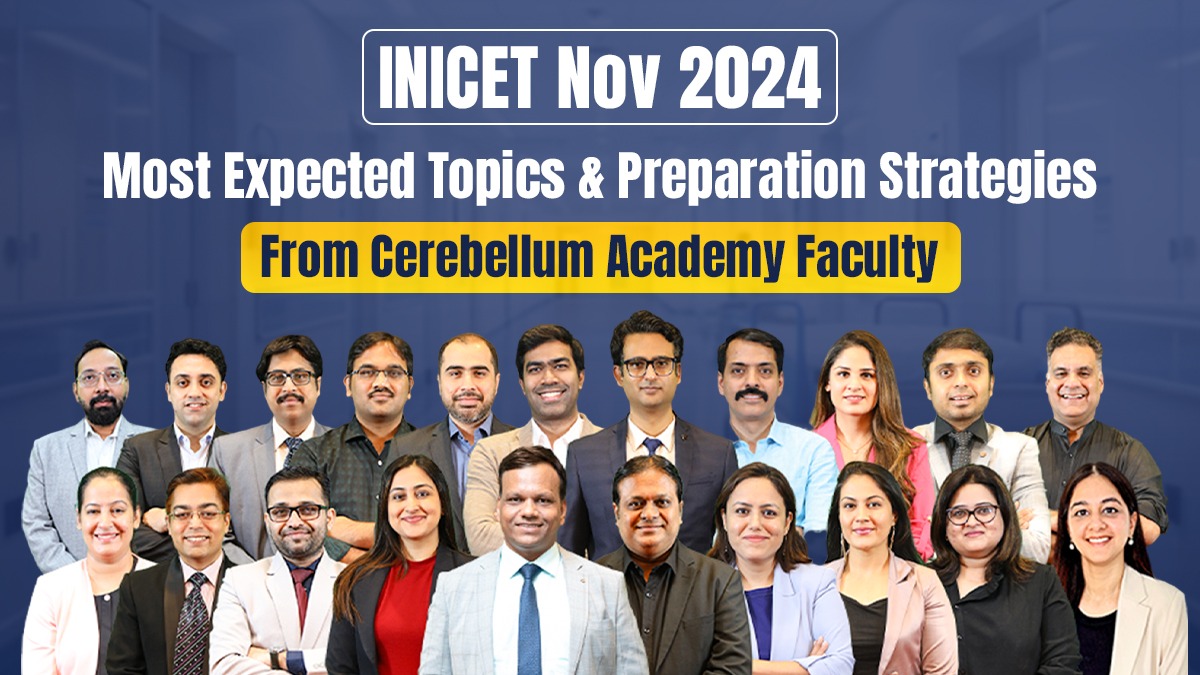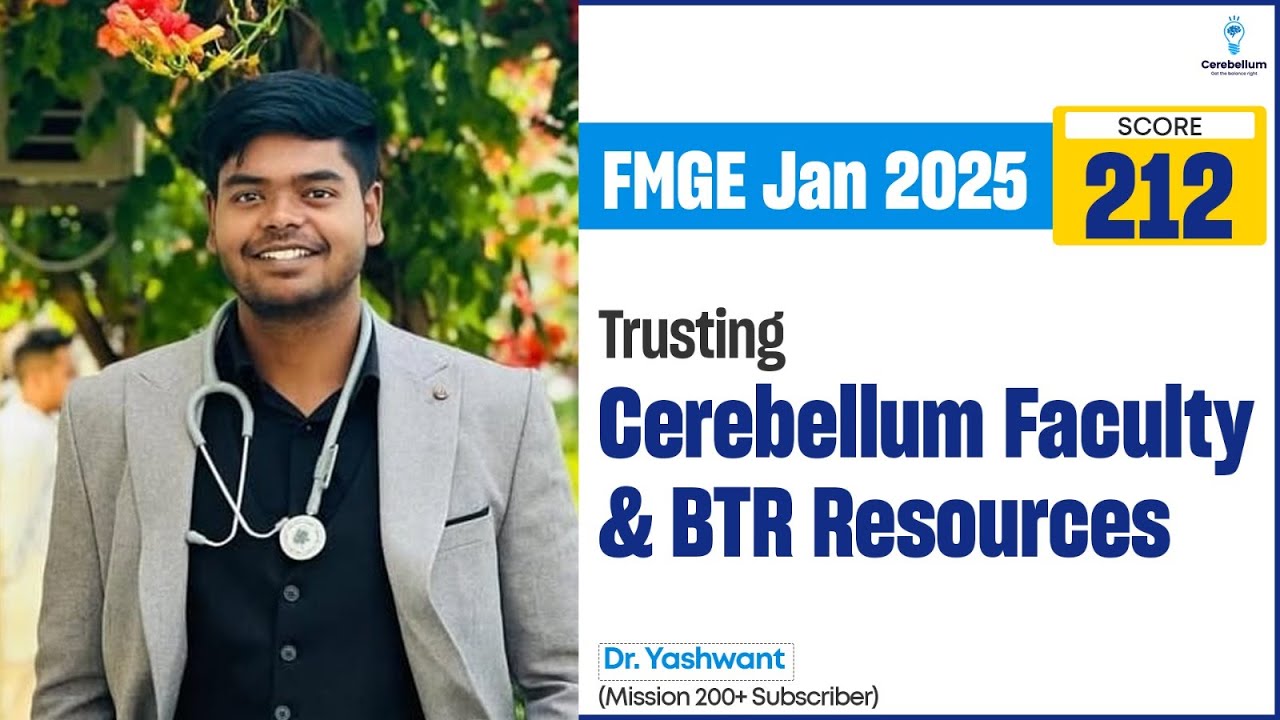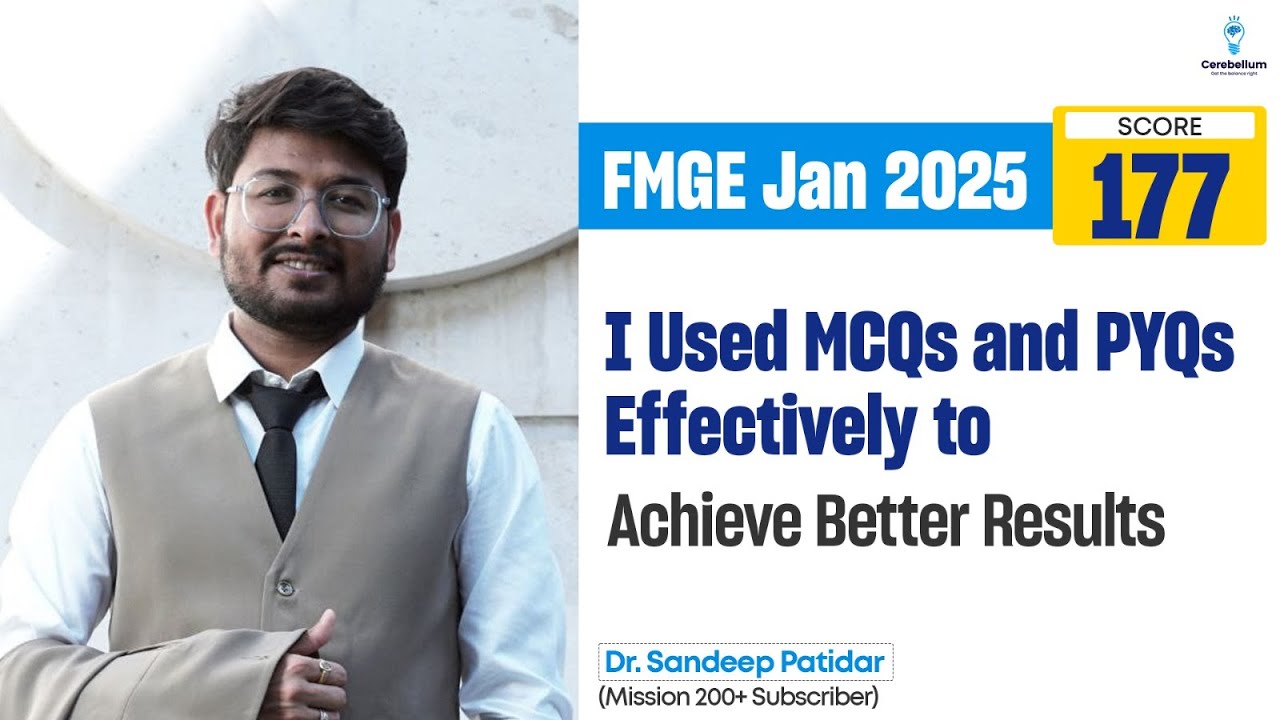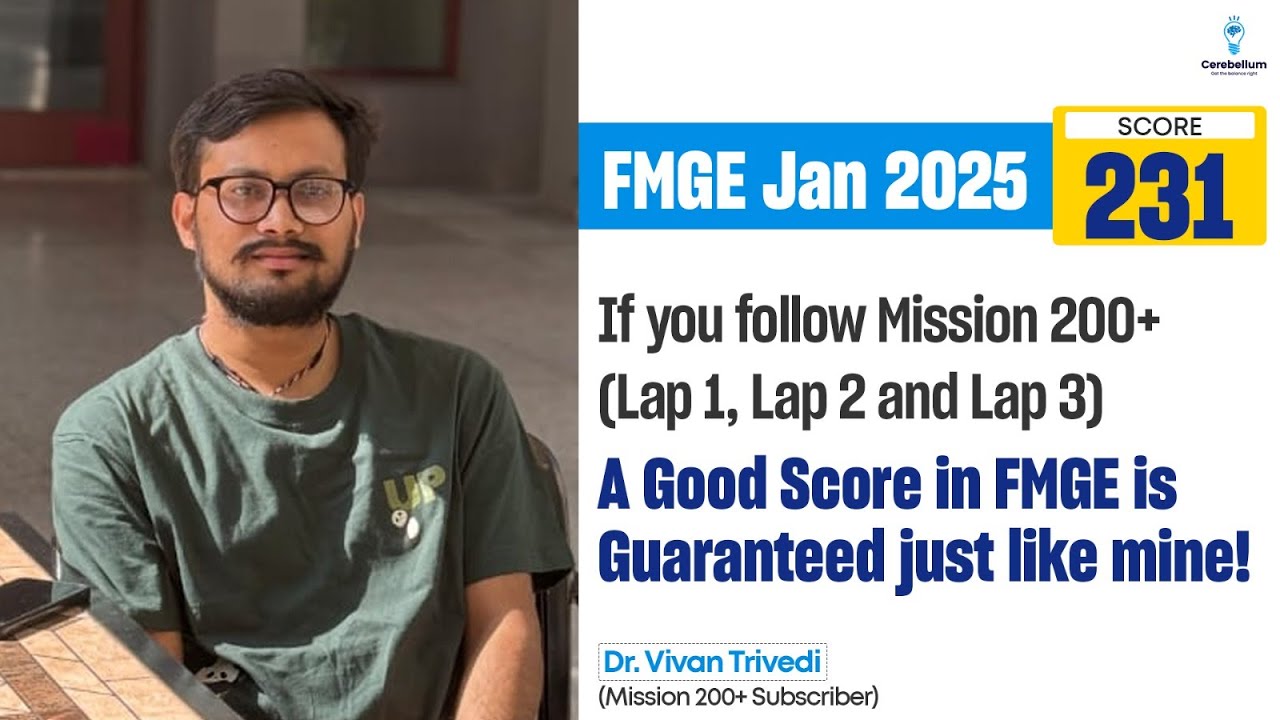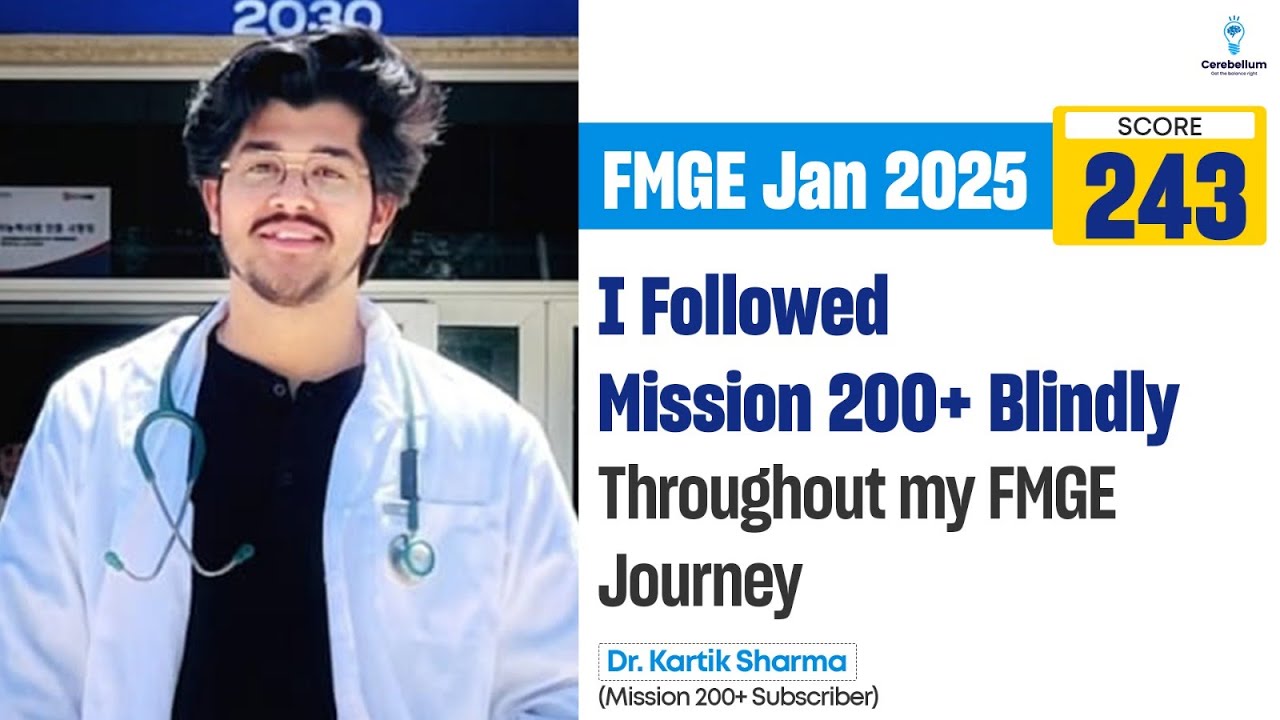Are you getting ready for INICET November 2024? Since, as a future medical practitioner, you will have to focus on the most important topics to make the most out of your INICET Nov 2024 preparation. Here, in this elaborate guide, we have gone through the most expected topics for the November 2024 INICET Exam across various specializations. Let’s get into the central areas you must master to succeed!
Understand the INICET Nov 2024 Exam Pattern
Before we get down to the specific topics, it is very important to know about the INICET Nov 2024 exam pattern. INI-CET is one of the most competitive entrance examinations that will take you on to postgraduate medical education at premier institutions across India.
Important Topics for INI CET by Specialty
Cerebellum Academy: Your Companion to Success in INICET
Ear, Nose, and Throat (ENT):
1. Ear:
2. Nose:
- Otitis media with effusion
- Ménière’s disease
- Otosclerosis
- WHO classification of hearing loss
- Inner and outer hair cells in the cochlea
- Auditory neuropathy
- Auditory pathway
- Otoacoustic emissions
- Brainstem evoked response audiometry (BERA)
- Sade classification of pars tensa retraction
- Pure tone audiometry
- Complications of chronic suppurative otitis media (CSOM)
- Wullstein classification of tympanoplasty
- Hearing aids
- Acoustic neuroma
- Benign paroxysmal positional vertigo (BPPV)
- Pinna hematoma
- Allergic rhinitis
- Rhinosporidiosis
- Mucormycosis (previously phycomycosis)
- Drainage of paranasal sinuses
- Olfaction
- Fungal sinusitis – Bent and Kuhn criteria
- Inverted papilloma
- Blood supply of the nasal septum
- X-ray paranasal sinuses (PNS) views
- Abnormal pneumatization patterns of air cells
3. Pharynx:
- Posterior pharyngeal wall anatomy
- Juvenile nasopharyngeal angiofibroma
- Adenoid hypertrophy
4. Larynx:
- Nerve supply of the larynx
- Vocal cord paralysis
- Post-laryngectomy voice rehabilitation
2. Medicine
- Endocrinology:
- Receptors and their pathways
- Anti-Diabetic Drugs: Special Indications and Side effects
- Diagnostic Criteria for DKA (Diabetic Ketoacidosis)
- Drugs of Bone & Calcium Metabolism
- Hypercortisolism
- Nephrology:
- Acid-Base Balance Disorders
- Electrolyte Abnormalities
- Features of types of RTA (Renal Tubular Acidosis)
- Acute Kidney Injury: Classification
- Factors affecting GFR (Glomerular Filtration Rate)
- Hematology:
- HL vs NHL (Hodgkin’s Lymphoma vs Non-Hodgkin’s Lymphoma)
- Myelodysplastic Syndrome
- Blood products & Blood transfusion
- Pharmacology:
- Diuretics: Mechanism of Action and Side effects
3. Surgery
- GI Tract
- Esophagus
- Motility disorders – barium and manometry
- Carcinoma of the esophagus surgery
- Zenker’s diverticulum imaging
- Stomach
- Infantile hypertrophic pyloric stenosis (IHPS), perforated peptic ulcer management
- Carcinoma of the stomach – pathology and treatment
- Appendix and Intestinal Diverticuli
- Meckel’s diverticula – investigations and treatment
- VID abnormalities
- Intestinal Obstruction
- X-ray of intestinal obstruction
- Intussusception, sigmoid volvulus
- Colon
- Colonic polyposis
- Surgery for colonic cancer
- Rectum
- Surgeries for rectal prolapse
- Anal Canal
- Types of fistula-in-ano and surgeries (including newer treatment)
- Hernia and Peritoneum
- Ventral hernia – types of repairs and EHS classification
- Complications of hernia repair including nerve injuries
- Laparoscopic inguinal anatomy
2. Hepato-Pancreatic-Biliary
- Liver
- Hydatid cyst and liver abscess
- Imaging and treatment of hepatoma (BCLC)
- Gallbladder (GB) and Biliary Tree
- CBD stones management
- Bile duct injury
- Investigations in biliary disease
- Pancreas
- Clinical features in acute pancreatitis, severity scores
- Endocrine tumors
- Procedures for chronic pancreatitis
3. Trauma
- General Trauma – Basic Principles
- Triage (important)
- Components of primary survey
- Chest Trauma
- Massive hemothorax, airway injury, and aortic injury
- Head and Neck Trauma
- Management of intracranial injury (EDH, SDH)
- Abdominal Trauma
- eFAST, CECT, laparotomy – how to choose
4. Urology
- Kidney and Ureter
- IBQ on renal imaging (IVU/RGU/MCU)
- Renal cell carcinoma (RCC) – imaging, staging, and treatment
- All urological trauma – renal, bladder, and urethra
- Urinary Bladder
- Management of bladder tumors
- Testis
- Carcinoma of the testis – investigations, treatment, and tumor markers
- Urethra, Penis, and Scrotum
- Management of carcinoma of the penis
- Fournier’s gangrene
- Prostate
- Carcinoma of the prostate – diagnosis and treatment
5. Pediatric Surgery
- Abdominal wall defects
6. Plastic Surgery
- Burns
- Burns calculation
- Plastic Surgery and Skin Tumors
- Flaps in head and neck
- Breast reconstruction
7. Vascular Surgery and Lymphatics
- Venous and Lymphatic Disorders
- CEAP for varicose veins including new changes
- DVT stockings
- Surgeries for varicose veins including EVLA
- IBQ on lymphedema
- Arterial Disorders
- Buerger’s disease
- Raynaud’s disease
- Imaging for peripheral vascular disease (PVD)
8. General Surgery
- Complications of TPN
- Diabetic foot/ulcer management
- Pressure sore management
- Submandibular stone management
- Types of modified radical neck dissection (MRND) and complications
- Premalignant conditions of the oral cavity
9. Breast and Endocrine
- Thyroid
- Investigations for thyroid nodules
- Complications of thyroidectomy
- Parathyroid, Adrenal, and MEN
- MEN syndrome components
- Primary hyperparathyroidism
- Breast
- Risk factors and screening, mammogram, and MRI of the breast
4. Pediatrics
- Respiratory System
- Pneumonia
- Croup
- Acute Epiglottitis
- Stridor
- Cardiovascular System
- Tetralogy of Fallot (TOF)
- Patent Ductus Arteriosus (PDA)
- Fetal circulation
- Transposition of Great Arteries (TGA)
- Total Anomalous Pulmonary Venous Return (TAPVR)
- Ebstein’s Anomaly
- Genetic Syndromes
- Down Syndrome
- Turner Syndrome
- Patau Syndrome
- Edwards Syndrome
- Angelman Syndrome
- Prader-Willi Syndrome
- DiGeorge Syndrome
- Williams Syndrome
- Central Nervous System
- Neural Tube Defects
- Febrile Seizures
- Glasgow Coma Scale (GCS)
- Hydrocephalus
- Gastrointestinal System
- Diarrhoea
- Celiac Disease
- Cystic Fibrosis
- Hirschsprung’s Disease
- Intussusception
- Infectious Diseases
- Measles
- Mumps
- Chickenpox
- Scarlet Fever
- Fifth Disease
- Sixth Disease
- Vasculitis
- Kawasaki Disease
- Takayasu’s Arteritis
- Buerger’s Disease
- Growth and Development
- Short Stature
- Fontanelles and Sutures
- Milestones
- Upper to Lower Segment Ratio
- Periods of Growth Deviation
- Breast Feeding
- Vaccination
- BCG Vaccine
- Rabies Vaccine
- ILR (Ice-Lined Refrigerator)
- Vaccine Vial Monitor (VVM)
- Neonatology
- Neonatal Jaundice
- Cephalohematoma
- Hypothermia
- Infant of Diabetic Mother
- Neonatal Resuscitation
- Neonatal Sepsis
- Feeding Guidelines (Gestation-wise)
- Micronutrients
- Pellagra
- Bitot’s Spots
- Classification of Vitamin A Deficiency
5. Anesthesiology
- Capnography
- High Flow Nasal Cannula
- Pre-Anesthetic Agents
- CPR (Cardiopulmonary Resuscitation)
- Local Anesthetics
6. Obstetrics and Gynecology
- Obstetrics
- Hypertensive disorders of pregnancy
- Antepartum Hemorrhage (APH)
- Postpartum Hemorrhage (PPH)
- Amniotic Fluid Embolism
- Cord Prolapse
- Uterine Inversion
- Retained Placenta
- Ectopic and Molar Pregnancy
- Down Syndrome Screening
- WHO 2018 Guidelines on Labor Management and Labor Care Guide
- Gynecology
- Amenorrhea
- Disorders of Sexual Differentiation
- Polycystic Ovary Syndrome (PCOS)
- Contraception (newer methods and clinical situations)
- Gynecological Oncology
- Operative Gynecology
7. Biochemistry
- Glycogen Storage Diseases
- DNA Repair Mechanisms
- Enzyme Kinetics and Inhibition
- PCR and Molecular Techniques
- Epigenetics
- CRISPR-Cas9 Gene Editing
- Amino Acid Metabolism Disorders
- Maple Syrup Urine Disease
- Phenylketonuria
- Alkaptonuria
- Urea Cycle and Ammonia Detoxification
- Lipid Metabolism Disorders
- Lesch-Nyhan Syndrome and Xanthine Oxidase Function
- Carnitine and Beta Oxidation of Fatty Acids
- Electron Transport Chain Inhibitors
- DNA Replication and Telomerase
- Gaucher Disease and other Lysosomal Storage Disorders
- Heme Metabolism and Lead Poisoning
- Alcohol Metabolism
- Vitamin Deficiencies
- Pyruvate Dehydrogenase Complex
- Glycolysis and Gluconeogenesis
- Protein Folding and Chaperones
8. Dermatology
- Basics of Dermatology
- Structure of the epidermis & dermis
- Skin lesions
- Vesiculobullous Disorders
- Pemphigus vulgaris
- Bullous pemphigoid
- Epidermolysis bullosa
- Dermatitis herpetiformis
- Infections
- Sexually Transmitted Diseases (STDs)
- Hand Foot Mouth Disease (HFMD)
- Molluscum contagiosum
- Herpes labialis
- Chikungunya fever (Melasma pigmentation)
- Maculopapular rash & Exanthem
- Verruca vulgaris / common wart
- Leprosy
- Impetigo
- Tinea
- Sporotrichosis / Mycetoma / Chromoblastomycosis
- Intertrigo
- Scabies
- Hair & Appendageal Disorders
- Trichotillomania
- Trichothiodystrophy, Trichorrhexis nodosa, Trichorrhexis invaginata
- Alopecia
- Acne
- Papulosquamous Disorders
- Psoriasis
- Lichen planus
- Pityriasis rosea
- Pityriasis rubra pilaris
- Dermatitis
- Allergic contact dermatitis (ACD)
- Patch test
- Drug-related Skin Reactions
- Fixed Drug Eruption (FDE)
- Toxic Epidermal Necrolysis (TEN) / Steven-Johnson Syndrome (SJS)
- Erythema multiforme
- Pigmentary Disorders
- Drugs causing pigmentation
- Segmental vitiligo
- Nevi
- Connective Tissue Disorders
- Dermatomyositis
- Scleroderma
- Other Dermatological Conditions
- Ichthyosis
- Skin lesions in systemic diseases
- Pellagra
- Cutaneous malignancies
- Lines in dermatology
9. Anatomy
- Basics & General Anatomy
- Joints
- Muscles (cadaveric image) & movements
- Head & Neck
- Cranial nerves
- Foramen of skull & structures passing through it
- Face: Arteries & nerves with clinical
- Triangles of neck
- Cadaveric section of head & neck & vertebral level (integrated with Radiology, ENT & Surgery)
- Dural venous sinuses (most important – cavernous sinus)
- Neuroanatomy
- Spinal cord & lumbar puncture
- Tracts & clinical
- Brain stem & brain stem syndromes
- Functional areas of brain (integrated with Stroke & TIA)
- Blood supply of brain
- White matter of brain (most important – corpus callosum & fornix)
- Basal nuclei & clinical
- Cadaveric section of brain with radiology integration
- Cerebellum
- Dermatome
- Upper Limb
- Brachial plexus, nerves of upper limb & clinical
- Arteries of upper limb & clinical
- Cadaveric images of upper limb
- Cubital fossa
- Short muscles of hand (Lumbricals, palmar & dorsal interossei)
- Anatomical snuff box
- Lower Limb
- Arterial supply with clinical
- Nerves of lower limb with clinical
- Venous drainage with clinical
- Cadaveric images of lower limb
- Femoral triangle & popliteal fossa
- Gluteal region & nerves (most important – Trendelenburg sign)
- Arches of foot with foot deformities
- Foot bones & ligaments (Ortho & Radiology integration)
- Thorax
- Intercostal space
- Lungs with impressions & bronchopulmonary segments (BPS)
- Heart with coronary circulation
- Transverse sections of thorax (with Radiology integration)
- Abdomen
- Anterior abdominal wall
- Peritoneum & peritoneal ligaments
- Epiploic foramen & Pringles maneuver
- Arteries of GIT, portal vein & shunt, abdominal aorta, internal iliac artery
- Important relationships of abdominal viscera (important for surgery)
- Inguinal canal & inguinal hernia
- Diaphragms of body & clinical
- Transverse sections of abdomen (with Radiology integration)
- Pelvis
- Pelvic diaphragm & clinical
- Urogenital diaphragm with perineal pouches
- Ischio-rectal fossa & clinical
- Bulbar urethra injury
- Prostate with clinical
- Embryology
- Pharyngeal apparatus
- CNS & CVS development
- High-yield points of general embryology
- Urachus
- Omphalocele & gastroschisis
- Neural crest cells derivatives
- Histology
- Epithelium
- Cartilage & collagen with clinical
- Tongue (with embryo & gross integration)
- Kidney, suprarenal gland & pancreas
- Lymphatic organs
- Respiratory tract
10. Forensic
- Inquest
- Stains
- Adipocere and mummification
- Age of ossification
- Sex determination by bones
- Strangulation and hanging
- Firearm injuries
- Toxicology (datura, cocaine, organophosphates, methanol, ethylene glycol, snakes)
11. Preventive and Social Medicine (PSM)
- History of Medicine
- Opium trade by China
- Discoveries
- Concepts of Health & Disease
- HDI, MDPI
- Palliative care
- Natural history of disease
- Isolation, Airborne precautions
- Epidemiology
- AR & PAR
- Mixed analytical study designs
- RCT, Meta-analysis & EBM
- Fish Diagram
- Component cause model
- Forest plot
- Vaccines & Cold Chain
- AEFIs
- Polysaccharide/DPT/RVV/Covid vaccines
- Screening of Disease
- Screening Vs Diagnosis
- PPV & NPV
- Validity/ Reliability
- ROC curve
- Bayes’ theorem
- Kaplan Meier curve
- Kappa statistic
- Communicable Diseases
- Dehydration management (IMNCI)
- Typhoid/ Cholera control measures
- Hepatitis B serum markers
- Scrub typhus & Trench fever
- Dog-bite management
- HIV-TB district classification
- HIV PEP
- STD color kits
- Injury management
- Malaria/ Dengue diagnosis
- Non-Communicable Diseases
- Visual impairment categories
- CHD markers
- National Health Programs, Policies & Legislations in India
- Leprosy/Malaria program indicators
- Leprosy/Malaria/TB treatment guidelines
- Anemia Mukt Bharat
- MTP Act
- Demography
- Fertility indicators
- Population pyramid
- Family Planning & Contraception
- Depot formulations
- Preventive Obstetrics, Pediatrics & Geriatrics
- RBSK
- JSSK
- IMNCI
- Causes of IMR/U5MR/NNMR
- HEADSS
- Nutrition & Health
- Pregnancy/Lactation RDA values
- Mineral deficiencies
- Social Sciences & Health
- Definitions, Theories of disease causation (Sociology)
- Adoption of idea/practice
- Health Economics
- GDP definition
- Environment & Health
- Water chlorination & quality
- Air quality
- Entomology vectors & larvae
- Biomedical Waste Management
- Mercury/Glassware/Pacemaker disposal
- Disaster Management
- Triage
- Post-disaster phase
- Occupational Health
- ESI Act
- Occupational cancers
- Genetics
- Human genome project
- HW Law
- Mental Health
- Mental health program & act
- Health Education & Communication
- Health propaganda
- Health motivation models
- Health Care System
- PHC Definition/Elements/Principles
- ASHA
- Health Planning & Management
- Universal health coverage
- Network analysis
- International Health
- Bioterrorism agents
- Biosafety levels
- International surveillance
- IHR
- WMA Declarations
- Biostatistics
- Central tendency, Dispersion & SD formula
- Normal/Skewed distributions
- Bar chart & Scatter diagram
- Statistical tests & Chi-square formula
- Statistical errors & p-value
- Confidence intervals
- Box and whisker plot
- Stem and leaf plot
12. Physiology
- Body Water & Cell Membrane
- Body water distribution
- Transport across cell membrane
- Resting Membrane Potential (RMP) & Action Potential (AP) in nerves, nodal tissue, and cardiomyocytes
- Nerve & Muscle Physiology
- Nerve fiber classification, injury types, and axoplasmic flow
- Sarcomere structure & Excitation-Contraction Coupling
- Cardiovascular System
- Heart sounds, Jugular Venous Pressure (JVP)
- Cardiac cycle & Pressure-volume curve
- Regulation of Cardiac Output
- Blood vessel types & applied physiology
- Hemodynamics principles
- Blood pressure regulation
- Cardiovascular (CVS) reflexes
- Respiratory System
- Mechanism of respiration
- Lung compliance & surface tension
- Lung volumes & capacities, V/Q Ratio
- Gas diffusion, Oxygen-Hemoglobin Dissociation Curve
- Neural & chemical regulation of respiration
- Hypoxia
- Nervous System
- Synaptic transmission
- Somatosensory receptors
- Pain physiology
- Ascending & descending tracts
- Special senses
- Cerebellum & basal ganglia
- Limbic system & hypothalamus
- EEG, sleep, and memory processes
- Renal System
- Tubular transport & counter-current mechanism
- Glucose transport, Renal Clearance & Glomerular Filtration Rate (GFR)
- Acid-base balance
- Endocrine System
- Types of hormone receptors
- Pituitary hormones, Pancreatic & Thyroid hormones
- Calcium homeostasis
- Gastrointestinal System
- GI secretions and hormones
- GI motility
13. Microbiology
- General Microbiology
- Microscopes
- Sterilization and disinfection
- Culture media
- Bacterial morphology and staining techniques
- Immunology
- Antigen-Antibody Reactions
- Immunodeficiency disorders
- Hypersensitivity reactions
- Bacteriology
- Gram-positive cocci
- Neisseria
- TB diagnosis
- Vibrio
- Enterobacteriaceae family
- Rickettsia
- Bacterial toxins
- Parasitology
- Parasites, host, and vectors
- Eggs in parasitology
- Leishmania
- Toxoplasma
- Filarial nematodes
- Taenia
- Plasmodium
- Virology
- Inclusion bodies
- Hepatitis serology
- Ebola virus
- Zika virus
- Rotavirus
- Parvovirus B19
- Rabies virus
- COVID-19
- Herpes viruses
- Oncogenic viruses
- Mycology
- Dimorphic fungi
- Clinical Microbiology
- Infective endocarditis
- Genital ulcer diagnosis
14. Pharmacology
- General Pharmacology
- Dose-Response Curve (DRC)
- Clinical Trials
- Receptors
- Autonomic Nervous System (ANS)
- Organophosphate (OP) Poisoning
- Myasthenia Gravis
- Scorpion Sting
- Glaucoma
- Blood Pressure (BP) Graphs
- Beta Blockers
- Autacoids
- Migraine
- Gout
- Rheumatoid Arthritis (RA)
- Cardiovascular System (CVS)
- Diuretics
- Digoxin
- Drugs Reducing Mortality in Congestive Heart Failure (CHF)
- New Anti-Angina Drugs
- Amiodarone
- Statins
- Endocrine System
- Octreotide
- Hyperthyroidism
- Antidiabetics
- Osteoporosis
- Selective Estrogen Receptor Modulators (SERMs)
- Central Nervous System (CNS)
- Alzheimer’s Disease
- Parkinsonism
- Epilepsy
- Extrapyramidal Symptoms (EPS)
- Lithium
- Hematology, Respiratory System, and Gastrointestinal Tract (GIT)
- Anticoagulants
- Asthma
- Peptic Ulcer
- Anticancer and Immunosuppressants
- Targeted Anticancer Drugs
- Rescue Therapy
- Immune Checkpoint Inhibitors
- Miscellaneous
- Sickle Cell Anemia
- Paroxysmal Nocturnal Hemoglobinuria (PNH), Antiobesity Drugs
- Newly Approved Drugs in the Last Six Months
15. Pathology
1. Mechanisms of cell death
2. Apoptosis
3. Pyroptosis
4. Necroptosis
5. Inflammatory Mediators
6. Cytokines
7. Coagulation Cascade
8. Autoimmune Disorders
9. Different Antibodies Present
10. Blood Transfusion & Grouping
11. BT Complications
12. Type of Blood for Routine & Emergency Transfusion
13. Lymphoma Difference in CD Markers & Site of Origin
14. Iron Deficiency Anemia: Findings & Differential Diagnosis
15. Morphological Appearance of Red cells
16. Neoplasia IHC & Diagnostic Techniques
17. Novel IHC Markers & Flow Cytometry
Get ready for INICET Nov 2024 with comprehensive study material, expert guidance, and support at Cerebellum Academy. Our mission is to help medical students and professionals prepare sincerely and succeed in their careers.
Upskilling Your INICET
Don’t fear the INICET Nov 2024 exam. Join Cerebellum Academy now to attain access to its latest, ultra-modern NEET PG/ INI CET 2.0. It is designed by experts and ensures that not a single one of the above included topics is left out. With practice questions along with personalized counseling for each student, we ensure you pass your INICET November 2024 exam with confidence.
Join us now and begin your journey towards success in INICET!
With the right resources, strategy, and determination, you are sure to conquer the INICET Nov 2024 exam and take the next step to a fuller expression of your medical profession. All the very best!

